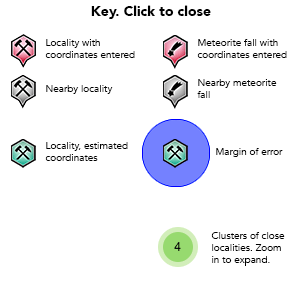Meuselbach meteorite, Schwarzatal, Saalfeld-Rudolstadt District, Thuringia, Germanyi
| Regional Level Types | |
|---|---|
| Meuselbach meteorite | Meteorite Fall Location |
| Schwarzatal | Town |
| Saalfeld-Rudolstadt District | Rural District |
| Thuringia | State |
| Germany | Country |
This page is currently not sponsored. Click here to sponsor this page.

Key
Latitude & Longitude (WGS84):
50° 34' 40'' North , 11° 5' 57'' East
Latitude & Longitude (decimal):
Locality type:
Meteorite Class:
Meteoritical Society Class:
Köppen climate type:
Nearest Settlements:
| Place | Population | Distance |
|---|---|---|
| Meuselbach | 1,373 (2012) | 0.9km |
| Cursdorf | 767 (2011) | 2.7km |
| Oberweißbach | 1,653 (2015) | 3.2km |
| Wildenspring | 231 (2011) | 3.4km |
| Deesbach | 498 (2011) | 3.8km |
Other Languages:
German:
Meuselbach Meteorit, Schwarzatal, Landkreis Saalfeld-Rudolstadt, Thüringen, Deutschland
Ordinary chondrite, veined (L6)
Fell, 19 May 1897; 870 g
A bolide appeared and, after sounds compared to thunder and cannon roars were heard, a small stone with a thin fusion crust fell into the ground where it created a small hole about 20 cm deep. The primary mineralogical features were established soon after its fall. The primary silicates (olivine and pyroxene) are found in chondrules and as small grains in matrix. The most important accessory phases — meteoritic iron, troilite and chromite are likewise found associated with the chondrules and throughout the matrix. Pervasive interior veining combined with colorless and brownish varieties of glass indicate that the preterrestrial Meuselbach meteorite experienced considerable shock during one or more collisions before its encounter with the earth. The olivine composition (Fa24) is indicative of the ordinary L( low-iron) ordinary chondrite group.
Meuselbach is one of the smaller of nine L chondrite falls to be recovered from Germany. For several decades the main mass has been held at Rudolstadt.
Select Mineral List Type
Standard Detailed Gallery Strunz Dana Chemical ElementsMineral List
2 valid minerals.
Meteorite/Rock Types Recorded
Note: data is currently VERY limited. Please bear with us while we work towards adding this information!
Select Rock List Type
Alphabetical List Tree DiagramDetailed Mineral List:
| ⓘ Chromite Formula: Fe2+Cr3+2O4 Reference: Linck, G. (1898): Der Meteorit (Chondrit) von Meuselbach i. Th. - Annalen des Naturhistorischen Museums in Wien 13: 103-114. |
| ⓘ 'Clinopyroxene Subgroup' Reference: Unlisted Editors (1906) Abhandlungen der Königlich Preussische Akademie der Wissenschaften aus dem Jahre 1906. Der Königlichen Akademie der Wissenschaften: Berlin. |
| ⓘ 'Fayalite-Forsterite Series' Description: Composition Fa24 Reference: Linck, G. (1898): Der Meteorit (Chondrit) von Meuselbach i. Th. - Annalen des Naturhistorischen Museums in Wien 13: 103-114.; Grady, M. M. (2000) Catalogue of Meteorites (5/e). Cambridge University Press: Cambridge; New York; Oakleigh; Madrid; Cape Town. 689 pages. |
| ⓘ 'Meteoritic Iron' Reference: Linck, G. (1898): Der Meteorit (Chondrit) von Meuselbach i. Th. - Annalen des Naturhistorischen Museums in Wien 13: 103-114. |
| ⓘ 'Pyroxene Group' Reference: Linck, G. (1898): Der Meteorit (Chondrit) von Meuselbach i. Th. - Annalen des Naturhistorischen Museums in Wien 13: 103-114.; Unlisted Editors (1906) Abhandlungen der Königlich Preussische Akademie der Wissenschaften aus dem Jahre 1906. Der Königlichen Akademie der Wissenschaften: Berlin. |
| ⓘ Troilite Formula: FeS Description: Troilite frequently rimmed by Fe-Ni metal and chromite Reference: Linck, G. (1898): Der Meteorit (Chondrit) von Meuselbach i. Th. - Annalen des Naturhistorischen Museums in Wien 13: 103-114. |
Gallery:
List of minerals arranged by Strunz 10th Edition classification
| Group 2 - Sulphides and Sulfosalts | |||
|---|---|---|---|
| ⓘ | Troilite | 2.CC.10 | FeS |
| Group 4 - Oxides and Hydroxides | |||
| ⓘ | Chromite | 4.BB.05 | Fe2+Cr3+2O4 |
| Unclassified Minerals, Rocks, etc. | |||
| ⓘ | 'Clinopyroxene Subgroup' | - | |
| ⓘ | 'Fayalite-Forsterite Series' | - | |
| ⓘ | 'Meteoritic Iron' | - | |
| ⓘ | 'Pyroxene Group' | - | |
List of minerals arranged by Dana 8th Edition classification
| Group 2 - SULFIDES | |||
|---|---|---|---|
| AmXp, with m:p = 1:1 | |||
| ⓘ | Troilite | 2.8.9.1 | FeS |
| Group 7 - MULTIPLE OXIDES | |||
| AB2X4 | |||
| ⓘ | Chromite | 7.2.3.3 | Fe2+Cr3+2O4 |
| Unclassified Minerals, Mixtures, etc. | |||
| ⓘ | 'Clinopyroxene Subgroup' | - | |
| ⓘ | 'Fayalite-Forsterite Series' | - | |
| ⓘ | 'Meteoritic Iron' | - | |
| ⓘ | 'Pyroxene Group' | - | |
List of minerals for each chemical element
| O | Oxygen | |
|---|---|---|
| O | ⓘ Chromite | Fe2+Cr23+O4 |
| S | Sulfur | |
| S | ⓘ Troilite | FeS |
| Cr | Chromium | |
| Cr | ⓘ Chromite | Fe2+Cr23+O4 |
| Fe | Iron | |
| Fe | ⓘ Chromite | Fe2+Cr23+O4 |
| Fe | ⓘ Troilite | FeS |
References
Sort by
Year (asc) Year (desc) Author (A-Z) Author (Z-A)Linck, G. (1898): Der Meteorit (Chondrit) von Meuselbach i. Th. - Annalen des Naturhistorischen Museums in Wien 13: 103-114.
Grady, M. M. (2000) Catalogue of Meteorites (5/e). Cambridge University Press: Cambridge; New York; Oakleigh; Madrid; Cape Town. 689 pages.
External Links
http://www.zobodat.at/stable/pdf/ANNA_13_0103-0114.pdf
http://www.encyclopedia-of-meteorites.com/test/meteorit_meuselbach.jpg
http://www.lpi.usra.edu/meteor/metbull.php?sea=&sfor=names&ants=&falls=yes&valids=&stype=contains&lrec=50&map=ge&browse=&country=Germany&srt=name&categ=L+chondrites&mblist=All&rect=&phot=&snew=0&pnt=Normal%20table&code=16626
http://www.encyclopedia-of-meteorites.com/test/meteorit_meuselbach.jpg
http://www.lpi.usra.edu/meteor/metbull.php?sea=&sfor=names&ants=&falls=yes&valids=&stype=contains&lrec=50&map=ge&browse=&country=Germany&srt=name&categ=L+chondrites&mblist=All&rect=&phot=&snew=0&pnt=Normal%20table&code=16626
Other Regions, Features and Areas containing this locality
This page contains all mineral locality references listed on mindat.org. This does not claim to be a complete list. If you know of more minerals from this site, please register so you can add to our database. This locality information is for reference purposes only. You should never attempt to
visit any sites listed in mindat.org without first ensuring that you have the permission of the land and/or mineral rights holders
for access and that you are aware of all safety precautions necessary.



